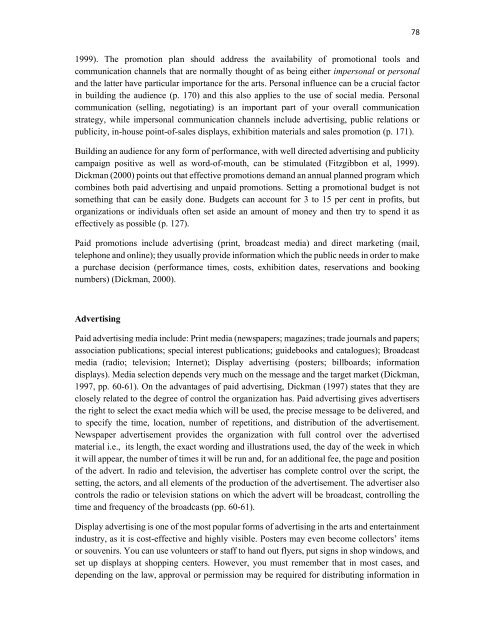and Music
Omega-Book
Omega-Book
Create successful ePaper yourself
Turn your PDF publications into a flip-book with our unique Google optimized e-Paper software.
78<br />
1999). The promotion plan should address the availability of promotional tools <strong>and</strong><br />
communication channels that are normally thought of as being either impersonal or personal<br />
<strong>and</strong> the latter have particular importance for the arts. Personal influence can be a crucial factor<br />
in building the audience (p. 170) <strong>and</strong> this also applies to the use of social media. Personal<br />
communication (selling, negotiating) is an important part of your overall communication<br />
strategy, while impersonal communication channels include advertising, public relations or<br />
publicity, in-house point-of-sales displays, exhibition materials <strong>and</strong> sales promotion (p. 171).<br />
Building an audience for any form of performance, with well directed advertising <strong>and</strong> publicity<br />
campaign positive as well as word-of-mouth, can be stimulated (Fitzgibbon et al, 1999).<br />
Dickman (2000) points out that effective promotions dem<strong>and</strong> an annual planned program which<br />
combines both paid advertising <strong>and</strong> unpaid promotions. Setting a promotional budget is not<br />
something that can be easily done. Budgets can account for 3 to 15 per cent in profits, but<br />
organizations or individuals often set aside an amount of money <strong>and</strong> then try to spend it as<br />
effectively as possible (p. 127).<br />
Paid promotions include advertising (print, broadcast media) <strong>and</strong> direct marketing (mail,<br />
telephone <strong>and</strong> online); they usually provide information which the public needs in order to make<br />
a purchase decision (performance times, costs, exhibition dates, reservations <strong>and</strong> booking<br />
numbers) (Dickman, 2000).<br />
Advertising<br />
Paid advertising media include: Print media (newspapers; magazines; trade journals <strong>and</strong> papers;<br />
association publications; special interest publications; guidebooks <strong>and</strong> catalogues); Broadcast<br />
media (radio; television; Internet); Display advertising (posters; billboards; information<br />
displays). Media selection depends very much on the message <strong>and</strong> the target market (Dickman,<br />
1997, pp. 60-61). On the advantages of paid advertising, Dickman (1997) states that they are<br />
closely related to the degree of control the organization has. Paid advertising gives advertisers<br />
the right to select the exact media which will be used, the precise message to be delivered, <strong>and</strong><br />
to specify the time, location, number of repetitions, <strong>and</strong> distribution of the advertisement.<br />
Newspaper advertisement provides the organization with full control over the advertised<br />
material i.e., its length, the exact wording <strong>and</strong> illustrations used, the day of the week in which<br />
it will appear, the number of times it will be run <strong>and</strong>, for an additional fee, the page <strong>and</strong> position<br />
of the advert. In radio <strong>and</strong> television, the advertiser has complete control over the script, the<br />
setting, the actors, <strong>and</strong> all elements of the production of the advertisement. The advertiser also<br />
controls the radio or television stations on which the advert will be broadcast, controlling the<br />
time <strong>and</strong> frequency of the broadcasts (pp. 60-61).<br />
Display advertising is one of the most popular forms of advertising in the arts <strong>and</strong> entertainment<br />
industry, as it is cost-effective <strong>and</strong> highly visible. Posters may even become collectors’ items<br />
or souvenirs. You can use volunteers or staff to h<strong>and</strong> out flyers, put signs in shop windows, <strong>and</strong><br />
set up displays at shopping centers. However, you must remember that in most cases, <strong>and</strong><br />
depending on the law, approval or permission may be required for distributing information in


